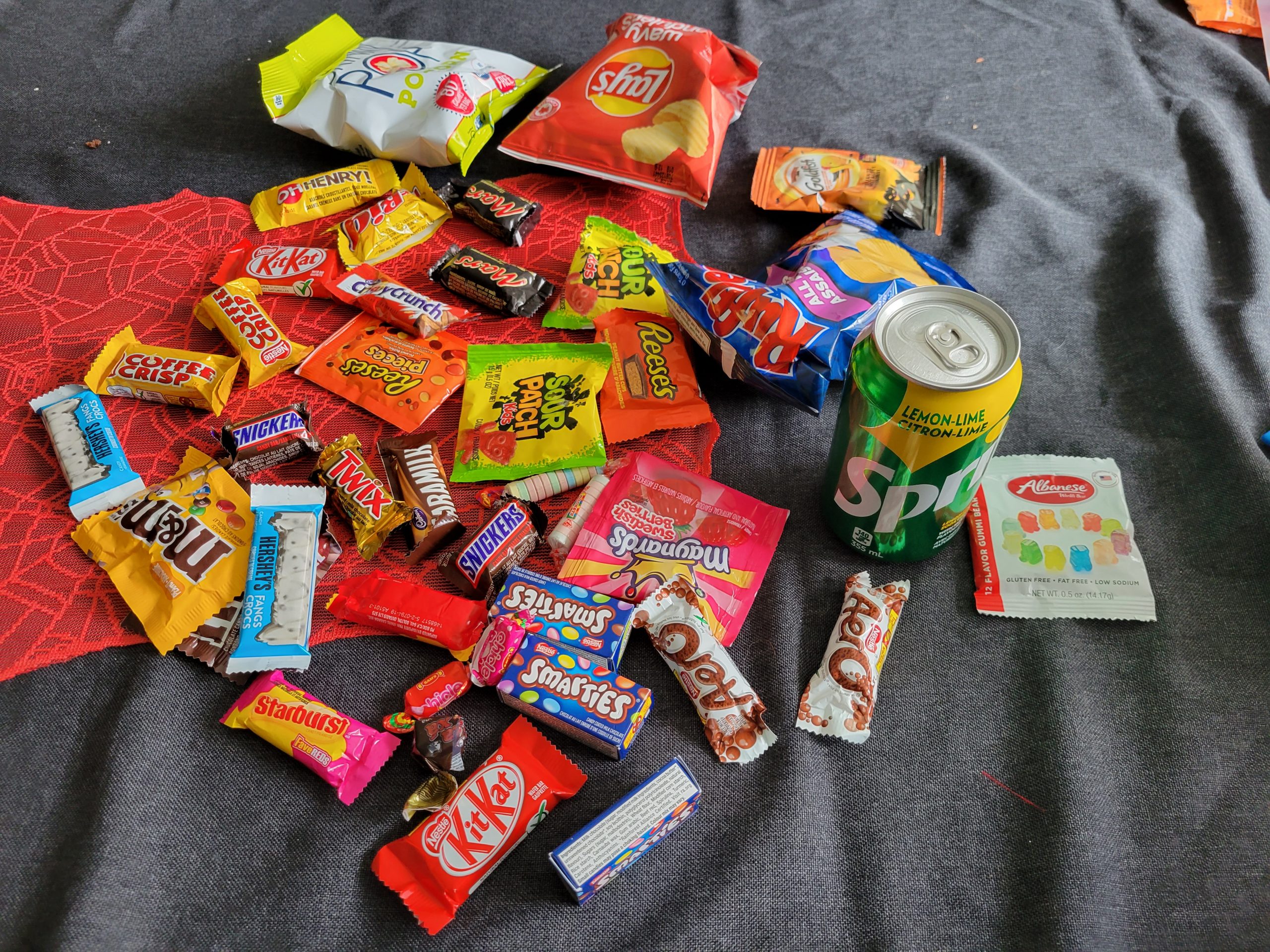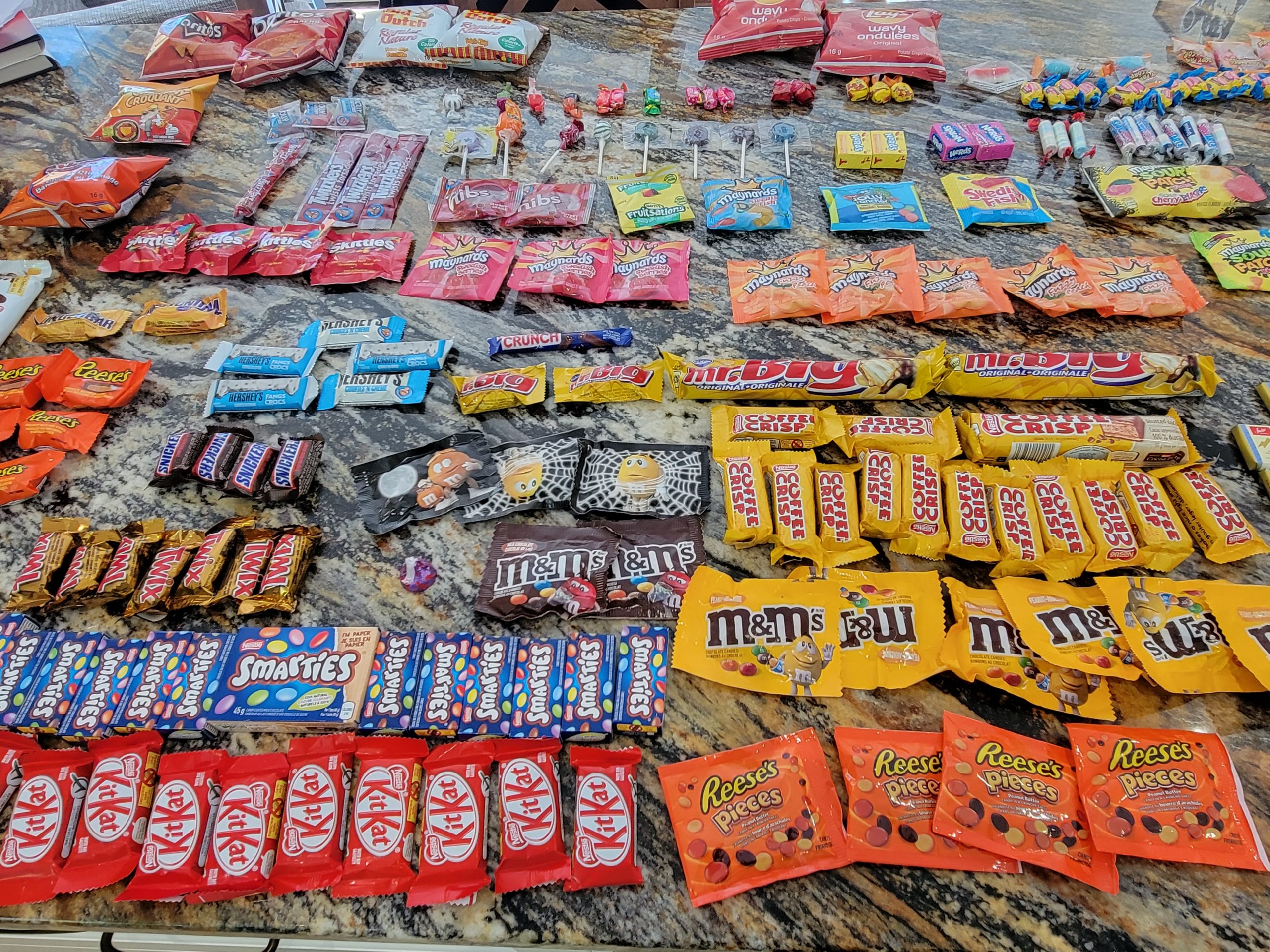3 Activity – The Three Questions when Designing an Organizing System
We ended the last chapter with the ideas that all organizing systems can be understood as designs that answer three interconnected questions:
- WHAT is being organized?
- WHY is it being organized?
- HOW is it being organized?
Let’s start developing our skills that make you a master organizer by answering these questions for a collection of resources that every kid organizes after “Trick or Treating” on Halloween.

Imagine that these are some of the items you collected
as a “Trick-or-Treater” on Halloween
After you answer each question, you should read the text that comes up to learn some lessons about organizing.
WHAT is being organized?
LESSON: “The items I collected” is the best answer because it it is balanced. It focuses on just the items that you collected, but it also includes the things that are not candy. Balancing the boundary between the things that are being organized and what things don’t belong in your organizing system is called defining the SCOPE. If the scope is too broad, there will be too many categories and your system will be very hard to use. If the scope is too narrow, it will be hard to create useful categories because the things are too similar to each other.
An example to help you understand this idea of balancing scope is your clothes closet. If you hang your pants, shirts, and other things that go on hangers in your closet without any organization, you would be treating every item as the same kind of thing, “things that go in the closet” — that’s a very broad scope . But if you separated pants from shirts, and then sorted them by activity (sports, school, party, and so on), and then by color, each category would have a very narrow scope and it would be hard to use that organization.
WHY is it being organized?
HOW is it being organized?
The simplest organizing principle that is often the starting point of every organizing system is “putting like things together.” This means that you create groups or piles of the same type of item — Snickers with Snickers, Skittles with Skittles, Mounds with Mounds, and so on. Very young kids who can’t read the labels can use item size or wrapper color as organizing principles that create piles of what they perceive as the same thing.
The more you know about the items in the collection, the more you can arrange these initial piles into larger groups of piles that are related in some way. These larger groups are usually based on conventional candy or food categories. So you’d create categories for hard candy, chewy candy, candy bars, chocolate bars, salty stuff like chips. and so on.
Within these broader categories, you might create sub-categories for “eat now” and “save for later” based on how much you like the items or how long they would last — because some candy “goes bad” after a while.

An organized collection of Halloween items
with chips, chewy, and chocolate categories
You might not have come up with exactly the same answers to the WHY and HOW questions and that’s OK. The most important thing is that the organizing principles you proposed (the HOW) enable you to accomplish your organizing goals (the WHY).
You should notice that the answers here don’t mention containers or bags or other storage things. These are necessary to put things away after you’ve designed the organizing system for your Halloween stash, but they are NOT part of its design.
Here’s why: Suppose after you arranged the items into categories, you put the items in each category into paper bags and wrote the name of the category on the bag. But then you decided that it would easier to find things if you used see-through plastic bags. This changes the storage of the items, but it DOES NOT CHANGE how they are organized.
Using these lessons to organize anything!
Trick or treating is a lot of fun, so you probably liked thinking and learning about organizing using that as an example. But remember, the secret to becoming a master organizer is to apply the same WHAT, WHY and HOW questions and methods when you organize anything!
LESSON 1: You started organizing your Trick-or-Treat collection by making an inventory. This is always important to do when you have to organize some set of resources. That’s because studying the things you need to organize makes you notice the features or properties that distinguish them — color, size, shape, purpose, whatever — and then you can use these properties to organize the collection.
LESSON 2:The purpose of sorting candy into categories based on how fast you need to eat it is a specific version of a broader idea that can used for other organizing projects. We can ask the WHY question in a more general way to mean “how long should I keep this thing?” Sometimes the answer is “no more” because the thing is old, worn out, or otherwise not useful to you any more. So “keeping” or “not keeping” categories almost always emerge when you start an organizing project. Why organize things you will never use again?
LESSON 3: Making an inventory and thinking about “keeping” or “not keeping” are also important things to do when you need to organize time. You organize time by creating a SCHEDULE in which you arrange the events or activities you will do in the order that you will do them. Your inventory of time is a diary of all the things you did or wanted to do during a couple of weeks. You analyze the diary to find the patterns of activities to schedule in the future. You should create “keeping” and “not keeping” categories because you never have enough time to do everything.

